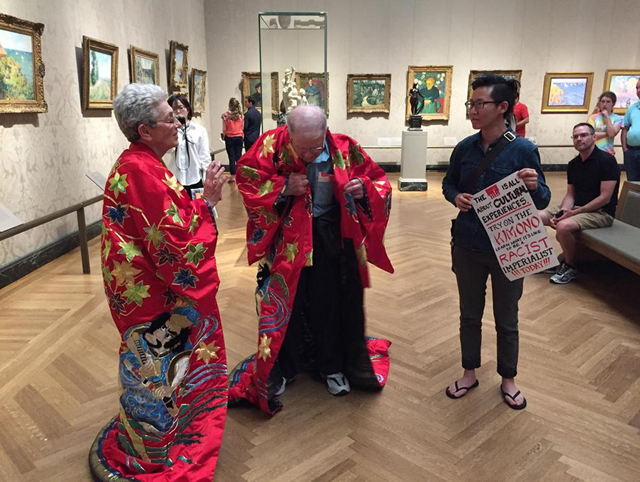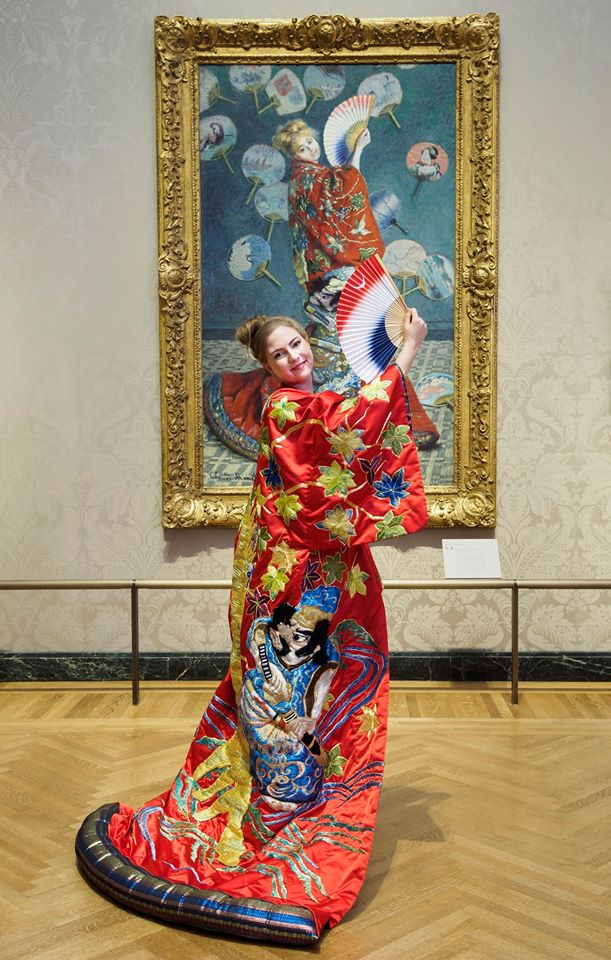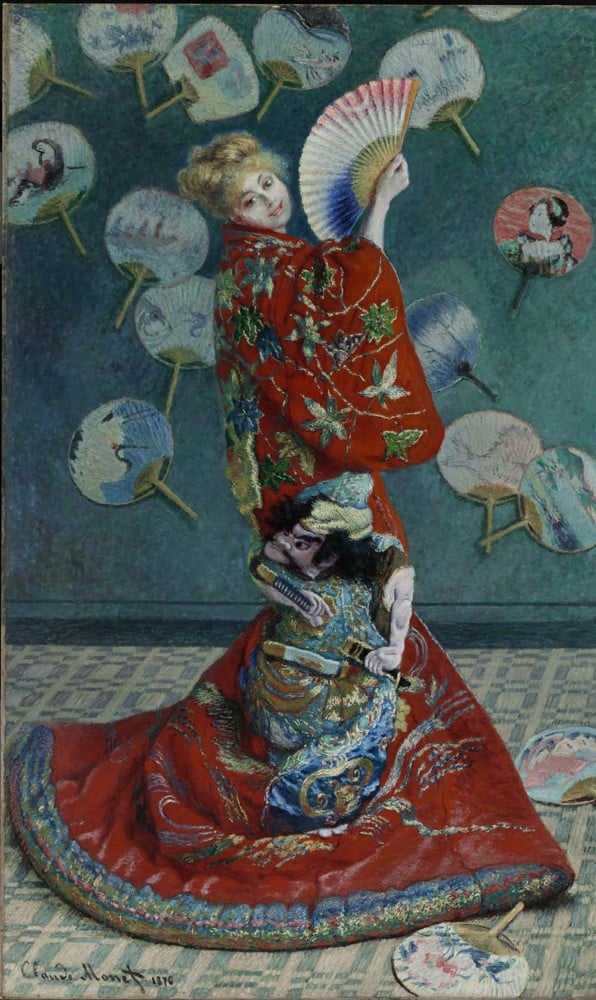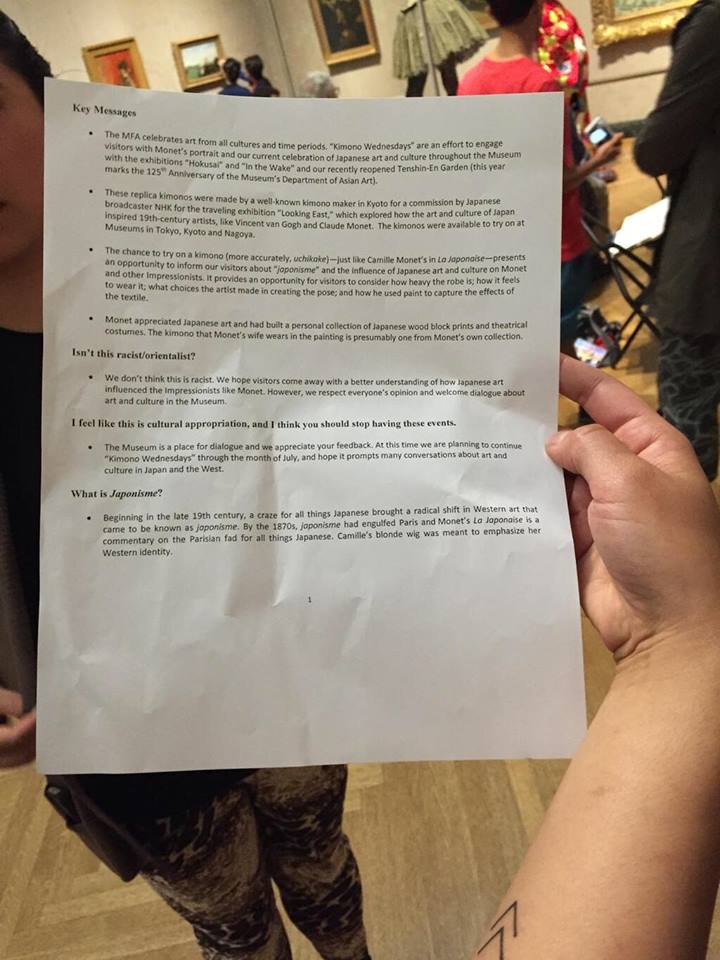Art World
Outrage at Museum of Fine Arts Boston Over Disgraceful “Dress Up in a Kimono” Event
Japonisme, after all, was the result of Western aggression.

Photo via Amber Ying, Twitter.
Japonisme, after all, was the result of Western aggression.

Brian Boucher


“Channel your inner Camille #Monet and try on a replica of the kimono she’s wearing in ‘La Japonaise.'”
Photo: Museum of Fine Arts Boston, via Facebook.
Protesters are up in arms over a controversial public program at Boston’s Museum of Fine Arts.
The museum has invited visitors to dress up in a kimono in front of Claude Monet’s 1876 painting La Japonaise (Camille Monet in Japanese Costume). The canvas shows the artist’s first wife dressed in a long kimono and dolled up in a blond wig “to emphasize her Western identity,” according to the museum.
Standing on a tatami mat, she brandishes a tricolor paper folding fan, with more paper fans hanging on the wall behind her. Her bright red robe is emblazoned with a spirit drawing a sword.
The painting comes from two years after Monet, along with Edgar Degas, Manet, Camille Pissarro, and Pierre-Auguste Renoir, founded an independent exhibition after their rejection from the Salon, the government-approved juried exhibition that took place annually in Paris. It has come to be known as the First Impressionist Exhibition.
Visitors are invited, via a June 19 Facebook post, to don a replica of the robe and “channel your inner Camille Monet.” The museum’s college ambassadors are on hand to help museumgoers dress up.
UPDATE: Museum of Fine Arts Boston Cancels Kimono Dress-Up Event After Being Accused of Insensitivity.

Claude Monet, La Japonaise (Camille Monet in Japanese Costume), 1876.
Photo: Museum of Fine Arts, Boston.
Monet’s canvas exemplifies a trend known as Japonisme, in which European aesthetes became infatuated with all things Japanese after the Meiji restoration, when the country became open to Western trade. That resumption of trade, of course, was not a neutral event. It was the result of American imperial expansion, and came only after Commodore Matthew Perry threatened to burn Japan’s capital to the ground.
The museum, for its part, sees Monet’s painting as a commentary on Japonisme: “Monet created a virtuoso display of brilliant color that is also a witty comment on the current Paris fad for all things Japanese,” a description of the painting says on the MFA’s website.
However, it’s not clear what the commentary consists of, and if there is a comment, it seems to lack any political dimension.
In the Japan Times, Jeff Michael Hammond writes about La Japonaise: “We can see why Monet dismissed it later as simply ‘a whim,’ with his other works showing an assimilation of Japanese aesthetic practices at a deeper level.”

A protester at the Museum of Fine Arts Boston.
Photo: via Amber Ying, Twitter.
Some responded with outrage to the museum’s Facebook post. On the blog Big Red and Shiny, Evan Smith writes that with this event, “we risk giving a pass to anyone clever enough to winkingly acknowledge their prejudices while freely exercising them.”
Facebook user Junko Goda branded the exercise as one of “appropriation (not appreciation!),” while commenter Kāpena wrote that the image was “one of the most vilely racist things I’ve ever seen.”
Interestingly, the painting came in for its share of criticism when it was first shown, though not of the same sort.
“Conservatives called the figure a ‘great doll, with nothing human about her face,’ a ‘demimondaine,’ a ‘two-headed Chinese,’ and a ‘scarlet machine,’” according to the museum.
A group called Stand Against Yellow-Face @ the MFA is organizing protests against what it calls “cultural appropriation and orientalism.” Demonstrators have taken to the galleries with signs brandishing messages like “Try on the kimono [and] learn what it’s like to be a racist imperialist today!”
Stand Against Yellow-Face complains that the activity has no edifying component.
“There is no education from curators or staff on the painting itself, nor the ‘orientalism’ that was occurring at the time, nor is there any sort of education on the kimono itself,” says the group. “The act of non-Japanese museum staff throwing these kimonos on [passersby] as a ‘costume’ event is an insult not only to our identities, experiences, and histories as Asian-Americans in America, but affects how society as a whole continues to deny our voices today.”
It goes on to say that the event merely invites visitors to “flirt with the exotic.” Perhaps they should travel to Japan and attend a nude drawing class or even its latest craze, the art aquarium?

The Museum of Fine Arts has distributed a one-page statement.
Photo: via Facebook, by Ames X Siyuan.
The museum, according to a July 1 post by group member Ames X Siyuan, distributed a one-page response. It points out that the institution is engaged in a broader “celebration of Japanese art and culture” that includes an exhibition devoted to Katsushika Hokusai (through August 9) and the show “In the Wake: Japanese Photographers Respond to 3/11” (through July 12), referring to the date of the Great East Japan Earthquake, in 2011.
UPDATE: The museum did not publish the above response. According to a press representative, it was distributed as an internal memo and was leaked to demonstrators.
The sheet notably responds to the question “Isn’t this racist/orientalist?” with a flat denial, without offering a defense: “We don’t think this is racist. We hope visitors come away with a better understanding of how Japanese art influenced the Impressionists like Monet.”
And what does this “better understanding” consist of?
The event “provides an opportunity for visitors to consider how heavy the robe is; how it feels to wear it; what choices the artist made in creating the pose; and how he used paint to capture the effects of the textile.”
Facebook commenter Rebecca Lange isn’t buying it.
“If this is an exhibit about orientalism,” she says, “shouldn’t people be dressing up like Monet/ignorant white men?”
The museum plans to continue the event throughout July, according to the one-page response.